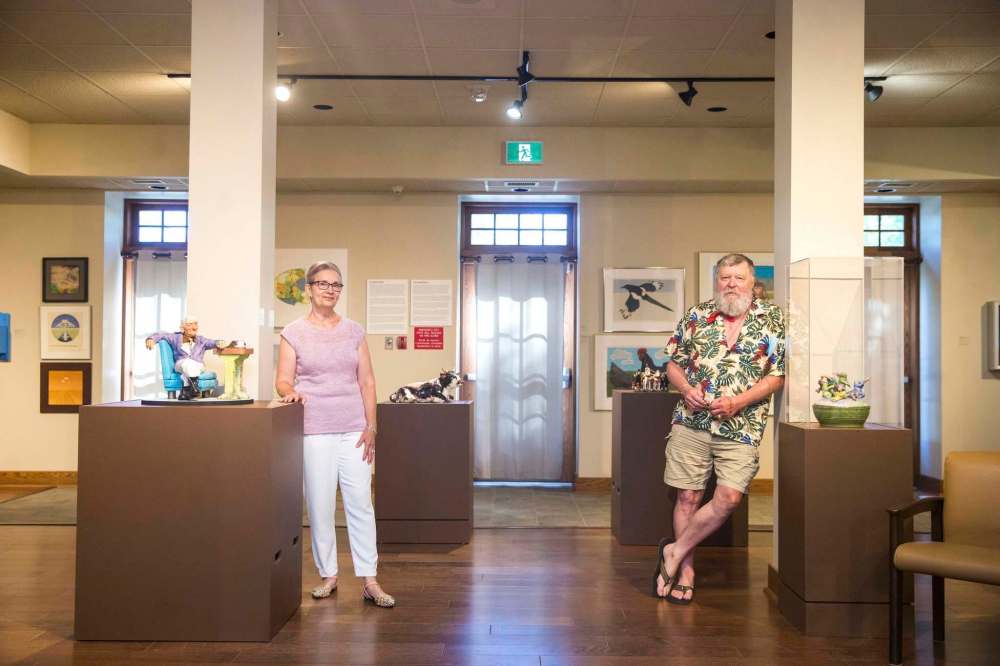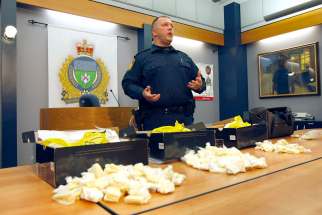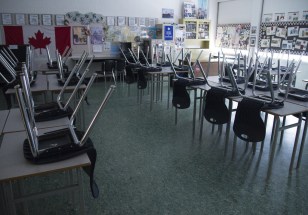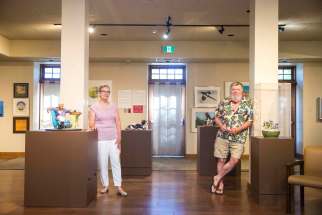Little gallery on the Prairies Artist, curator convince art exhibit to make unplanned stop at St. B hospital
Read this article for free:
or
Already have an account? Log in here »
To continue reading, please subscribe:
Monthly Digital Subscription
$0 for the first 4 weeks*
- Enjoy unlimited reading on winnipegfreepress.com
- Read the E-Edition, our digital replica newspaper
- Access News Break, our award-winning app
- Play interactive puzzles
*No charge for 4 weeks then price increases to the regular rate of $19.00 plus GST every four weeks. Offer available to new and qualified returning subscribers only. Cancel any time.
Monthly Digital Subscription
$4.75/week*
- Enjoy unlimited reading on winnipegfreepress.com
- Read the E-Edition, our digital replica newspaper
- Access News Break, our award-winning app
- Play interactive puzzles
*Billed as $19 plus GST every four weeks. Cancel any time.
To continue reading, please subscribe:
Add Free Press access to your Brandon Sun subscription for only an additional
$1 for the first 4 weeks*
*Your next subscription payment will increase by $1.00 and you will be charged $16.99 plus GST for four weeks. After four weeks, your payment will increase to $23.99 plus GST every four weeks.
Read unlimited articles for free today:
or
Already have an account? Log in here »
Hey there, time traveller!
This article was published 29/07/2020 (1959 days ago), so information in it may no longer be current.
A hospital might not be the first place you’d expect to find a calming, peaceful art exhibit about the Prairies, but the Buhler Gallery at St. Boniface Hospital is home to exactly that.
A Prairie Vernacular: Folk and Contemporary Art Narratives of Life on the Canadian Prairies is a collaboration among multiple galleries that examines historical and contemporary representations of the artistic vernacular of the Canadian Prairies.
“Vernacular” is described in the exhibition media release as “a genre of art made by individuals untrained in the visual arts, who may not even identify themselves as artists.”
“The relationship on the Prairies between folk or vernacular art and contemporary art that engages in the vernacular has been complex and, perhaps, somewhat symbiotic, stemming from a shared interest in Prairie experience, culture, environment and sensibilities as compelling sources for artistic practice,” the release says.

The genre of vernacular art rose to prominence in 19th-century France thanks to the work of symbolist artist Henri Rousseau, a self-taught painter whose work was known as Native or Primitive, but the idea didn’t migrate to Canada until the 1950s, when artists and curators — growing weary of modernism — became drawn to the integrity and rawness of the form.
While its traditional history is dominated by settler-colonial narratives, A Prairie Vernacular includes the work of Indigenous artists including Percy Plain Woman and Sherry Farrell Racette, as well as a statement from Carmen Robertson, a writer and scholar of art history and Indigenous peoples, to provide context for the genre and the work it encompasses, opening it up to alternative representations of the Prairie experience and histories that diversify the concept of vernacular art.
Originally curated by Jennifer McRorie, director and curator of the Moose Jaw Museum and Art Gallery, and Joanne Marion, director and curator of the Esplanade Arts and Heritage Centre in Medicine Hat, the exhibition has made its way to Winnipeg thanks to a chance meeting at the Mackenzie Art Gallery in Regina.
“We were having a show there,” says Bill Lobchuk, one of the artists featured in the exhibition, “and in the afternoon there was a panel discussion.”
“This has basically taken the place of the WAG in showing contemporary local work. You can see how art is really intertwined with our culture here.” – Artist Bill Lobchuk
Through the discussion, Lobchuk met the curators of the show and asked when it would be coming to Manitoba. Upon learning that there were no planned exhibition dates here, he introduced the curators to his friend and Buhler Gallery curator Leona Herzog.
The exhibition is a pared-down version, but with 120 pieces on display, it is still the biggest show the gallery has ever hosted.
“The walls are covered,” says Herzog. “With the nature of this show, it works.”
“It’s like a circus,” Lobchuk says.
Lobchuk, himself a venerable figure on the Prairie visual arts scene, began his career in 1966 after graduating with an art diploma from the University of Manitoba. He knew he didn’t want to teach, so instead, he opened his own screen-printing shop.

“I did teach for a couple years but I hated it,” says Lobchuk, who partnered with artist Len Anthony to open the Grand Western Canadian Screen Shop, which existed from 1968 to 1988 in a storefront at 50 Princess St. in the Exchange District.
“Our task at the screen shop was to experiment with all kinds of possibilities,” he says. “Can we do this? That was the question.”
Herzog has displayed Lobchuk and Anthony’s work next to each other, an homage to their longtime creative partnership, which lasted until Anthony’s death in 2018.
An open critic of the Winnipeg Art Gallery and the lack of Manitoba representation on its walls, Lobchuk is thrilled the Buhler Gallery was able to host an exhibit that exclusively features artists from the Prairie provinces.
“This has basically taken the place of the WAG in showing contemporary local work,” he says. “You can see how art is really intertwined with our culture here.”

Lobchuk grew up in Plumas and has maintained a lifelong passion for the rural Prairie landscapes of his childhood.
“I grew up at a farm until I was school-age, and then we were back to the farm all the time for weddings and funerals and other social engagements,” he says. “And then I bought myself a farm. It was a homestead, a log cabin, with a stone well and log outhouses, stuff like that.”
Lobchuk sold his farm home a few years ago and now resides in Winnipeg, where he continues to make art.
“I’ve got a new form of silk screening I’m doing,” he says. “The whole formula has changed. It’s not the way we used to do it. Ours was terrible chemicals like acetone and Varsol and now they have ink in a plastic bag and a track that prints all colours all at once.”
“I’m not even sure what the new technique is called,” says Lobchuk. “I’m still experimenting, you know?”
Frances.Koncan@freepress.mb.ca
Twitter: @franceskoncan

Frances Koncan (she/her) is a writer, theatre director, and failed musician of mixed Anishinaabe and Slovene descent. Originally from Couchiching First Nation, she is now based in Treaty 1 Territory right here in Winnipeg, Manitoba.
Our newsroom depends on a growing audience of readers to power our journalism. If you are not a paid reader, please consider becoming a subscriber.
Our newsroom depends on its audience of readers to power our journalism. Thank you for your support.









